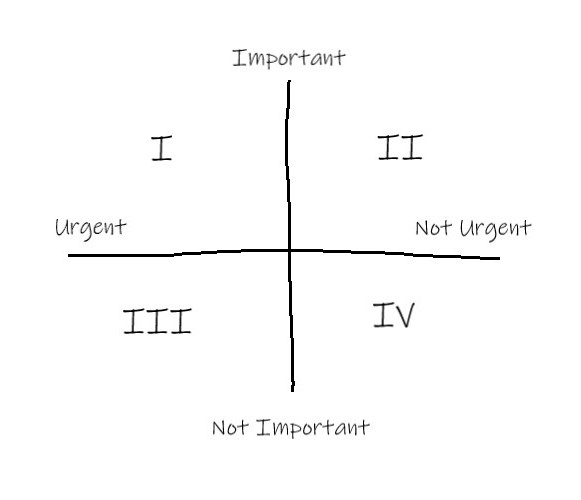We’re finally at the Habit in Covey’s The 7 Habits of Highly Effective People where the name of this blog, Q2 Leader, comes from. As with all the habits, Covey covers a lot of ground, so we’ll be looking at an overview of the chapter.
4 Generations of Time Management
Covey explains that there are four generations of time management, and that each one builds on the previous. Gen 1 is characterized by notes and checklists. (I have to admit I’m fond of Gen 1 time management!). As you might imagine, just having notes and checklists doesn’t provide any sense of when things need to get done. That’s where gen 2 comes in.
Gen 2 time management is characterized by calendars and appointments in the calendar. So now we know when things are scheduled. But what things need to be scheduled first?
Gen 3 time management answers that question. With gen 3, we prioritize our activities, figuring out which adds the most value and scheduling that in first. Gen 3 is characterized by daily planning. The knock on gen 3 time management is that it is very rigid, and it’s difficult to take advantage of spontaneous opportunities.
Gen 4 time management is not about time – it’s about managing ourselves. The fourth generation “time manager” focuses on building relationships and on results. We’ll explore ideas on how to plan a gen 4 week in a future post.
Time Management Matrix

Quadrant I is where we address the important and the urgent. This can be firefighting, and some urgent emails or text messages. If we have a very short due date for a project, we’ll be spending time in Quadrant I.
Quadrant III is where we address the urgent but the unimportant. Interruptions, some email, some (or most?) text messages may fall into this category.
Activities in Quadrants I and III are urgent, and we react. Something comes up all of a sudden, and we deal with it.
Quadrant IV is where unimportant and non-urgent activities occur. Busy work, time wasters, some fun stuff falls into this quadrant.
If we spend a lot of time in Quadrants III and IV, we’re probably not very effective people. We may be rather happy, but we’re not accomplishing much.
If we spend a lot of time in Quadrant I, we’re certainly getting things done, but not many of these things lead to growth.
Quadrant II, which is where important and non-urgent activities take place, focuses on relationship building, visioning, recreation, and growth. Is it urgent that you read a chapter of a book that will lead to self-improvement? Probably not. But is it important? It is if you want to add the most value and get the most out of life.
The name of this blog is Q2 Leader. It is named after Quadrant II, where this important but not-urgent work is done. It’s where we grow and learn and engineer our lives. The objective of Quadrant II management, according to Covey, is to “manage our lives effectively – from a center of sound principles, from a knowledge of our personal mission, with a focus on the important as well as the urgent…”
Per Covey, we should work to spend more time in Quadrant II. Interestingly, if we make time to do Quadrant II activities, we’ll end up doing fewer Quadrant I activities. This is so because Quadrant II is where we plan, come up with strategy, look at the pros and cons, and figure out risks. We also take care of ourselves in Quadrant II by doing activities like hobbies and exercise that give us energy. And, we build relationships.
Why did I want to name a blog after a quadrant in a time management matrix? Because it’s in Quadrant II that we learn who we want to be, and who we work to become. It took me many years to become familiar with self-improvement concepts, and I want to share with you what I’ve learned to either give you a shortcut, reinforce what you have already learned, or provide you with a new concept or two. One comment I get is, “why don’t they teach this in school?” I don’t know the answer, but I do know that when I spend time in Quadrant II my life becomes more satisfying because I can add more value to others.
Delegation
Delegation, per Covey, is when we give responsibility to other qualified people. He talks about two kinds of delegation, “gofer” delegation and stewardship delegation. “Gofer” delegation is about delegating activities, and telling people what to do. Stewardship delegation is about results. Covey states this works best if 5 things are mutually understood and committed to:
- Desired results
- Guidelines
- Resources
- Accountability
- Consequences
Stewardship delegation relies on trust.
“Trust is the highest form of human motivation”.
Stephen Covey, The 7 Habits of Highly Effective People
tl;dr
Habit 3 from Covey’s The 7 Habits of Highly Effective People talks about the four generations of time management, and focuses on gen 4. The fourth generation is all about managing ourselves, not time. The Time Management Matrix with axes of important and urgent get us to think about where we spend our time and on what. This blog is named for Quadrant 2, where important but non-urgent work is done. And, finally, stewardship delegation focuses on giving responsibility to qualified people.
engineer your life
- Read Habit 3 in The 7 Habits of Highly Effective People: Powerful Lessons in Personal Change
- Reflect on which quadrant most of your activities in a day or week fall. Are you mostly in Quadrant I and II, or is most of your time spent in Quadrants II and IV? If the latter, consider what changes you could make to shift into Quadrant II.